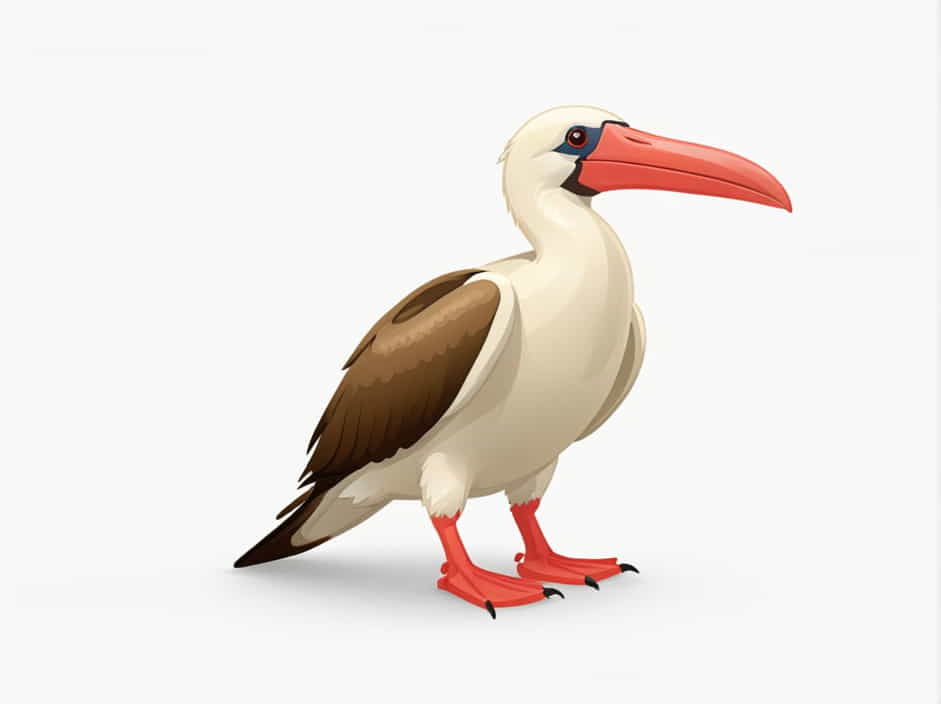The red-footed booby (Sula sula) is a fascinating seabird known for its striking red feet, long wings, and excellent diving skills. These birds are part of the booby family and are found in tropical and subtropical oceans worldwide. They are expert fishers and spend most of their lives at sea, only coming to land to breed.
In this topic, we will explore the appearance, habitat, diet, behavior, and conservation status of the red-footed booby.
1. What Does a Red-Footed Booby Look Like?
The red-footed booby is medium-sized compared to other seabirds, but it has distinct features that make it easy to recognize.
Physical Characteristics
- Size: About 28 inches (70 cm) long with a wingspan of 4.5 feet (137 cm).
- Color Variations: They come in different color morphs, including white, brown, and mixed patterns.
- Feet: Bright red feet, which are one of their most unique features.
- Beak: Pale blue with a pinkish base.
- Eyes: Surrounded by a ring of bare skin, which can be blue or red.
Unlike some birds that change color with age, red-footed boobies maintain their bright red feet throughout their lives.
2. Where Do Red-Footed Boobies Live?
Red-footed boobies are found all over the world, particularly in warm oceanic regions.
Geographic Range
- Tropical and subtropical waters of the Pacific, Atlantic, and Indian Oceans.
- Commonly seen in places like the Galápagos Islands, the Caribbean, and islands in the Pacific Ocean.
- They prefer isolated islands and atolls for breeding.
Preferred Habitat
- They spend most of their time flying over open oceans and only come to land for breeding.
- They build nests in trees or shrubs, unlike other booby species that prefer ground nesting.
3. What Do Red-Footed Boobies Eat?
Red-footed boobies are carnivorous seabirds that primarily feed on fish and squid.
Diet and Hunting Techniques
- Their main prey includes flying fish, sardines, anchovies, and squid.
- They use a spectacular diving technique, plunging into the water from heights of up to 50 feet (15 meters) to catch fish.
- They can also snatch flying fish in mid-air as they leap out of the water.
Their sharp eyesight and speed make them highly effective hunters.
4. How Do Red-Footed Boobies Behave?
Red-footed boobies have unique behaviors that help them survive in their environment.
Flying and Diving
- They have long, narrow wings that allow them to glide effortlessly over the ocean.
- Their streamlined bodies help them dive deep into the water to catch prey.
Breeding and Nesting
- They breed in large colonies, often on remote islands.
- Unlike other boobies, they build nests in trees or bushes, which provides protection from predators.
- Mating displays involve the male showing off his red feet and performing head shakes.
Social Behavior
- They are social birds and are often seen flying in small groups.
- They communicate using soft whistles and grunts.
5. How Long Do Red-Footed Boobies Live?
These birds have a relatively long lifespan for seabirds.
Lifespan and Survival
- Average lifespan: 15 to 20 years, but some live even longer.
- Their survival depends on factors like food availability, predators, and environmental changes.
6. Are Red-Footed Boobies Endangered?
Red-footed boobies are not currently endangered, but they do face some threats.
Conservation Status
- Classified as Least Concern (LC) by the IUCN Red List.
- Population numbers remain stable, but some local colonies are declining due to habitat loss.
Threats to Their Survival
- Climate change affects ocean temperatures and food availability.
- Human activities like fishing and pollution can harm their environment.
- Invasive species such as rats and cats can attack eggs and chicks.
Conservation efforts focus on protecting nesting sites and reducing ocean pollution.
7. Interesting Facts About Red-Footed Boobies
- They are the smallest of all booby species.
- Their name comes from the Spanish word “bobo,” meaning “fool,” because sailors thought they were clumsy on land.
- They can fly for long hours without resting, thanks to their energy-efficient wings.
- They swallow fish whole without chewing.
- Unlike other seabirds, they nest in trees rather than on the ground.
The red-footed booby is a remarkable seabird with its bright red feet, excellent diving skills, and long-distance flying ability. Found in tropical oceans worldwide, these birds play an important role in marine ecosystems by controlling fish populations.
While they are not endangered, their survival depends on healthy ocean environments and protection from human-related threats. By understanding and appreciating these birds, we can help ensure that they continue to thrive in the wild.
